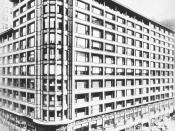mainly notes, needs a little work but ideas are all there and has great opening -
What impact has technology had on architecture of the 20th century?
Throughout the nineteenth century, architecture refused to have anything to do with industry; it had been concerned solely with monumental projects glorifying the state and giant civic structures expressing the pride of its people. This however, all changed with the dawn of the twentieth century. Industrial production became an integral part of modern society and a new relationship was forged between man and machine. From the nineteen hundreds on, architecture was viewed in this new light. Modernism and the optimistic belief that architecture could change the future of society through a synthesis of science and technology was the result. It reflected a new ideal for humanity - one that linked man to a new rational culture in tune with mechanization and efficiency. Technology directly affected architecture by facilitating the creation of new materials with which to build.
These new materials freed the architect from engineering limitations of the past and allowed for new rational designs based on a buildingÃÂs function. But most importantly, these designs were given form by a new optimistic ideal - that rational design would make for a rational society. Technology transformed architecture into a tool for social and cultural reform.
The industrial revolution gave three new materials to the architect of the 20th century: reinforced concrete, steel and glass. The new materials were inexpensive, mass produced and flexible to use. These affected American cities profoundly by allowing greater density through higher buildings. Imagine the typical office floor plate as we know it: open space with a few columns. You couldn't go as high or have such long spans between columns with timber frame. Chicago is a great example of...


